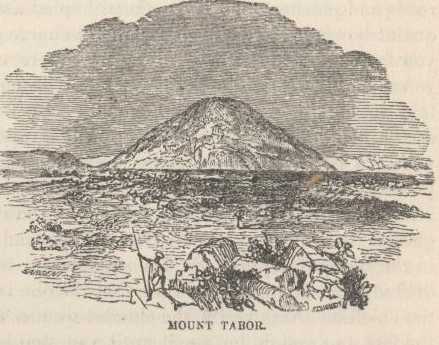We reached Tabor safely, and considerably in advance of that old iron-clad swindle of a guard. We never saw a human being on the whole route, much less lawless hordes of Bedouins. Tabor stands solitary and alone, a giant sentinel above the Plain of Esdraelon. It rises some fourteen hundred feet above the surrounding level, a green, wooden cone, symmetrical and full of grace—a prominent landmark, and one that is exceedingly pleasant to eyes surfeited with the repulsive monotony of desert Syria. We climbed the steep path to its summit, through breezy glades of thorn and oak. The view presented from its highest peak was almost beautiful. Below, was the broad, level plain of Esdraelon, checkered with fields like a chess-board, and full as smooth and level, seemingly; dotted about its borders with white, compact villages, and faintly penciled, far and near, with the curving lines of roads and trails. When it is robed in the fresh verdure of spring, it must form a charming picture, even by itself. Skirting its southern border rises “Little Hermon,” over whose summit a glimpse of Gilboa is caught. Nain, famous for the raising of the widow’s son, and Endor, as famous for the performances of her witch are in view. To the eastward lies the Valley of the Jordan and beyond it the mountains of Gilead. Westward is Mount Carmel. Hermon in the north—the table-lands of Bashan—Safed, the holy city, gleaming white upon a tall spur of the mountains of Lebanon—a steel-blue corner of the Sea of Galilee—saddle-peaked Hattin, traditional “Mount of Beatitudes” and mute witness to brave fights of the Crusading host for Holy Cross—these fill up the picture.

To glance at the salient features of this landscape through the picturesque framework of a ragged and ruined stone window—arch of the time of Christ, thus hiding from sight all that is unattractive, is to secure to yourself a pleasure worth climbing the mountain to enjoy. One must stand on his head to get the best effect in a fine sunset, and set a landscape in a bold, strong framework that is very close at hand, to bring out all its beauty.
There is nothing for it now but to come back to old Tabor, though the subject is tiresome enough, and I can not stick to it for wandering off to scenes that are pleasanter to remember. I think I will skip, any how. There is nothing about Tabor (except we concede that it was the scene of the Transfiguration,) but some gray old ruins, stacked up there in all ages of the world from the days of stout Gideon and parties that flourished thirty centuries ago to the fresh yesterday of Crusading times. It has its Greek Convent, and the coffee there is good, but never a splinter of the true cross or bone of a hallowed saint to arrest the idle thoughts of worldlings and turn them into graver channels. A Catholic church is nothing to me that has no relics.
Down at the foot of Tabor, and just at the edge of the storied Plain of Esdraelon, is the insignificant village of Deburieh, where Deborah, prophetess of Israel, lived. It is just like Magdala.